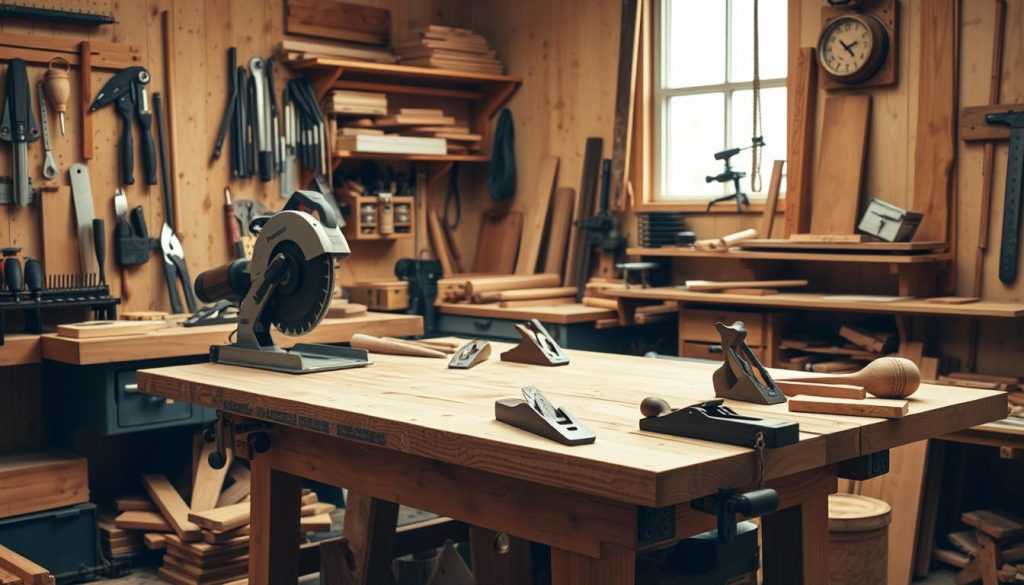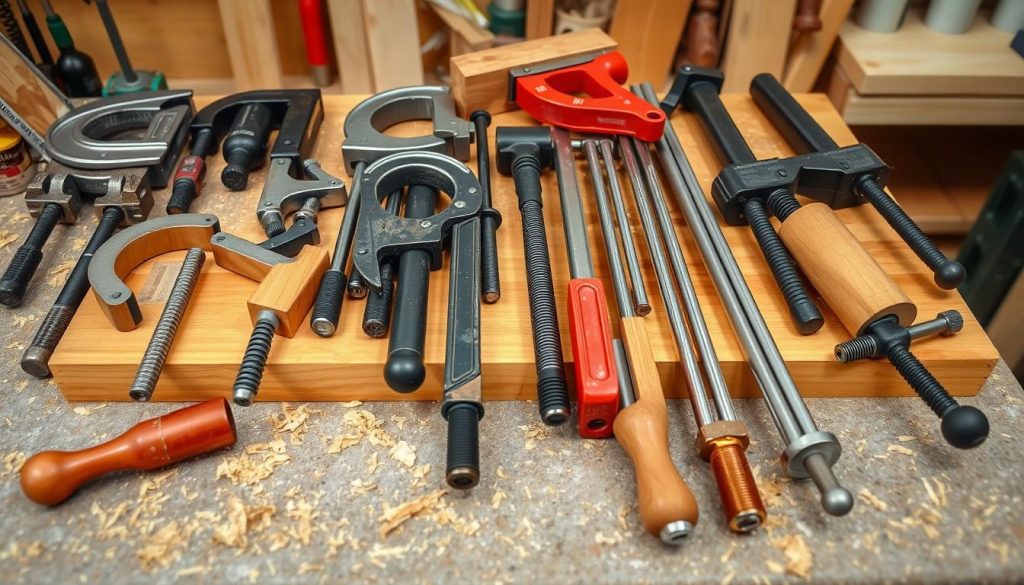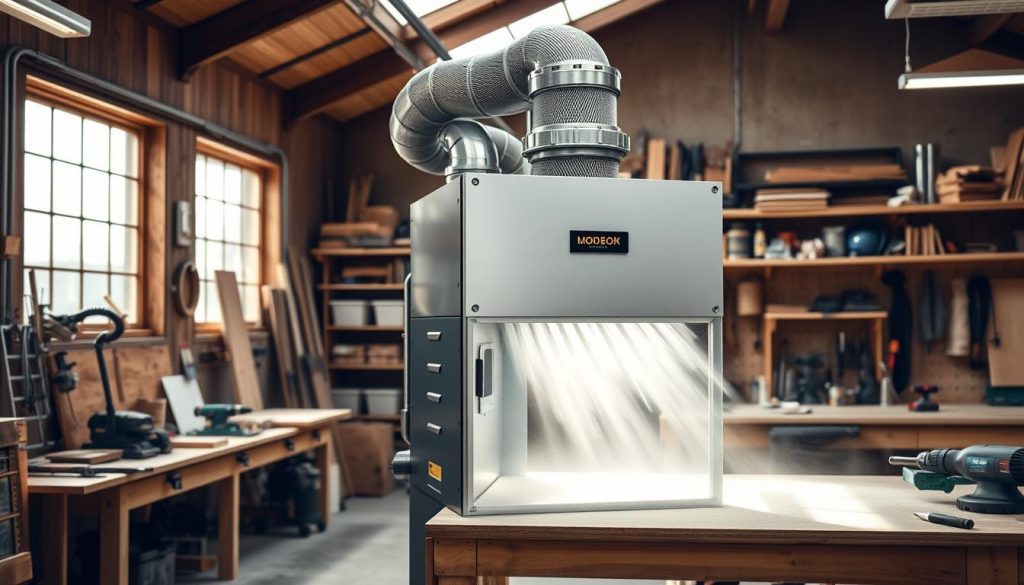Creating amazing woodworking projects needs the right tools in your workshop. Whether you’re experienced or new, knowing the key tools is vital for top-notch results. This guide will cover the top ten tools every woodworking shop should have.

The table saw is at the heart of any woodworking shop. It makes precise cuts, including rip, cross, and dado cuts. The router is also key, shaping, grooving, and profiling wood with great control. Chisels, both manual and powered, are essential for detailed joinery and work.
Orbital sanders are top tools for smoothing surfaces. The bandsaw is a must for curved and irregular cuts. Dust collection systems, like shop vacs and stationary collectors, keep your workspace clean and safe.
The jointer and planer are crucial for flat, square lumber. The miter saw is great for precise frame joints. The circular saw is excellent for rip, cross, and bevel cuts on big pieces.
Key Takeaways
- The ten most important woodworking tools for a workshop are a table saw, router, chisels, orbital sander, bandsaw, dust collector, jointer, planer, miter saw, and circular saw.
- A table saw is a versatile and crucial tool for woodworking tasks due to its accuracy, jigs, and array of uses.
- An orbital sander is ranked as the second most important tool, emphasizing its value despite limited functions compared to other power tools.
- Recommendations for good and best options for some tools, like the Ridgid contractor saw and Sawstop for table saws, as well as Jet and Laguna for bandsaws.
- The importance of a jointer for traditional woodworking projects requiring dimensional lumber for square glue-ups is highlighted.
Understanding Basic Woodworking Tool Requirements
Woodworking is a craft that needs many tools for different tasks. Power tools are fast and efficient, but hand tools are still key. Knowing the good and bad of both is important for woodworkers.
Power Tools vs Hand Tools
Power tools like table saws and drills are great for precise work. They speed up cutting, drilling, and sanding. But, hand tools like chisels and saws give more control for fine details.
Safety Equipment Essentials
Keeping your workspace safe is essential. You need eye protection, earplugs, and masks to avoid injuries and health issues. Good safety gear lets you work safely and focus on your craft.
Workshop Space Considerations
How you set up your workshop affects your work. You need enough room for tools and materials. Organizing your space well makes woodworking more fun and efficient.
The Table Saw: Heart of Your Workshop
In woodworking, the table saw is key to any good workshop. It’s great for making precise cuts like rip cuts, crosscuts, and dado cuts. Knowing what a good table saw can do is crucial for your projects.
Look for a table saw with a motor of 3 to 5 horsepower. These saws can cut through thick wood easily. Also, features like SawStop safety and adjustable parts make your work safer and more accurate.
Contractor saws and cabinet saws have their own benefits. Contractor saws are easy to move and less expensive, perfect for hobbyists. Cabinet saws, however, are more powerful and stable, ideal for professionals.
Choosing the right table saw means focusing on safety and proper use. Tools like riving knives and outfeed tables improve your saw’s performance. Learning to use a table saw well opens up new possibilities in woodworking.
Selecting the Perfect Bandsaw
The bandsaw is a key tool in woodworking. It’s great for resawing and making curves. But, with so many options, picking the right one can be tough. Let’s look at what matters most.
Blade Types and Sizes
The blade is the bandsaw’s heart. The type and size affect its performance. For general tasks, a 3 teeth per inch blade with a 1/2-inch width is best.
For resawing, the Wood Slicer® Resaw Bandsaw Blade from Highland Woodworking is excellent. It leaves fewer marks and cuts faster. For ripping thicker boards, a 3/4-inch resawing blade is needed, but only for larger saws.
Highland Woodworking offers great value in blades. Timber Wolf blades are also popular but pricier.
Common Bandsaw Applications
The bandsaw is versatile. It’s great for resawing and making curves. This makes it perfect for various projects, from furniture to musical instruments.
For ripping and resawing, the Grizzly G0513ANV 17-inch bandsaw is a good choice. It has a 2 HP motor. Other brands like JET, Powermatic, Rikon, and Laguna also have options for different needs and budgets.
Maintenance Tips
Keeping your bandsaw in top shape is important. Regularly check and adjust the blade tension and tracking. Also, keep it clean and the wheels aligned for better performance and longevity.
Understanding the key features and considerations helps you choose the right bandsaw. This will improve your woodworking and enhance your skills.
Essential Measuring and Marking Tools
Accurate measurement and precise marking are key to successful woodworking. Having the right tools makes a big difference in your work’s quality and speed. Tools like tape measures, carpenter’s squares, and marking gauges are crucial.
A good tape measure is essential. Look for a steel rule that measures down to 1/32″ for detailed work. Also, a 6-inch folding wooden rule is handy for longer lengths. Use a machinist square for setting up tools and marking crosscuts. A sliding bevel helps in duplicating odd angles.
- Tape measure: 6″ and 12″ steel rules with 1/32″ increments
- Machinist square: Essential for tool setup and marking crosscuts
- Sliding bevel: Useful for transferring and duplicating angles
Other key tools include a marking knife, mechanical pencil, and a 4-inch double square. This tool combines a combination square and a machinist square. A steel rule with a hook is great for measuring from edges. Stop blocks and templates, like Veritas’ Miter Hook, ensure consistent results.
Protractors, angle gauges, and digital calipers offer precise angle and measurement. Marking gauges with hardened steel or brass rods are durable and smooth. They’re perfect for laying out lines and patterns. Quality measuring and marking tools improve your woodworking’s accuracy and efficiency.
Power Drills and Drilling Equipment
A reliable power drill is key for your woodworking tools. You can choose between a cordless or corded drill. Each has its own benefits.
Cordless drills are great for moving around your workshop. They come with strong 18-volt batteries. This means you can do many drilling tasks without worry.
Cordless vs. Corded Options
If you need lots of power, a corded drill press is perfect. These tools are strong and good for heavy tasks. They also keep working without stopping for battery charge.
Drill Bits and Accessories
- Drill bits vary in size and type for different jobs. Twist bits are good for most drilling. But Forstner and hole saws make clean holes.
- Tools like countersinks and deburring help your drills do more. They make your work look professional.
- Having the right drill bits and tools is important. They help with many woodworking tasks, like making pocket holes or installing hardware.
Choosing the right power drill matters. Good tools and accessories improve your woodworking. With the right equipment, you can make beautiful pieces for your home or workshop.
Circular Saws: Types and Applications
Circular saws are essential for woodworkers. They are versatile and efficient for cutting different materials. These tools are great for both rip cuts, following the wood grain, and crosscuts, cutting across the grain.
They come in various sizes, from small 3 1/2-inch to big 10-inch models. This range allows users to handle many projects with precision.
Circular saws have different blade types for different needs. Rip blades are for long cuts, while crosscut blades make smooth cuts across the grain. The best choice is a combination blade, which works well for both types of cuts.
These blades, with their unique tooth counts, ensure clean cuts on wood, plastic, and even metal.
The power and size of a circular saw depend on the task. Small, cordless models are great for moving around, while bigger, corded saws are better for heavy cuts. Always wear eye and ear protection when using a circular saw for safety.
Professional Woodworking Tools for Precision Work
Woodworkers serious about their craft know the value of top-notch tools. Brands like Festool, SawStop, and Powermatic offer tools that promise unmatched accuracy and durability. These tools also come with advanced features that boost your project’s quality.
Premium Tool Brands
Festool is celebrated for its cutting-edge power tools and accessories. Many pros choose Festool for its high-end woodworking solutions. SawStop is known for its table saws with top-notch safety features, making work safer. Powermatic, a name trusted for decades, offers sturdy and reliable tools for tough woodworking tasks.
Investment Considerations
High-end tools might cost more upfront, but the long-term gains are worth it. These tools are built to last, with features that enhance your workflow and reduce mistakes. Investing in the right tools can take your woodworking to the next level, allowing you to handle more complex projects confidently.
Whether you’re an experienced woodworker or just starting, exploring premium tools can change the game. Understanding the value of professional-grade equipment opens doors to precision, efficiency, and satisfaction in your woodworking journey.
Sanders and Surface Preparation Tools
Getting a smooth finish is key in woodworking. Sanders are the top tools for this task. From the strong belt sander to the accurate orbital sander, each tool has its own role. Let’s dive into the world of sanders and tools for preparing surfaces to improve your woodworking.
The random orbital sander is very versatile. It mixes the speed of a belt sander with the detail of an orbital sander. This results in a smooth, even finish. The random motion also reduces swirl marks, making it great for prep before painting or finishing.
- The Festool 150mm brushless model is a favorite among pros, offering top performance and less vibration.
- Sanding blocks are key for flat, even surfaces. They let you apply even pressure and get into tight spots.
Good surface prep is vital for a great woodworking project. Start with coarse sandpaper grits to quickly remove material. Then, move to finer grits for a smooth finish. Always wear dust masks and safety goggles for a safe work area.
With the right sanders and tools, you can turn rough surfaces into beautiful pieces. Whether it’s furniture, cabinetry, or any project, these tools will help you get the perfect finish every time.
Clamps and Securing Devices
In woodworking, clamps are key for holding parts together, applying pressure during glue-ups, and securing workpieces. You’ll find everything from strong pipe clamps to flexible bar clamps. Each clamp has its own role in the workshop.
Types of Woodworking Clamps
- Pipe Clamps: Affordable and versatile, pipe clamps come in various sizes. They can apply a lot of pressure.
- Bar Clamps: With a wide range of capacities, bar clamps are perfect for glue-ups and securing big pieces.
- C-Clamps: Small but mighty, C-clamps are great for holding parts in place during detailed woodworking tasks.
- Strap Clamps: Ideal for oddly shaped or curved pieces, strap clamps apply even pressure.
Clamping Techniques
Using clamps correctly is crucial for great woodworking results. Whether gluing, joining edges, or preparing for cutting, the right clamping method matters. Try different clamps and positions to find the best approach for your task.

Having a variety of clamps in your workshop is important. Make sure you have quality pipe clamps, bar clamps, C-clamps, and strap clamps. This will help your projects come together smoothly.
Router Selection and Uses
Woodworkers love the wood router for its many uses. It’s great for making edge profiles, intricate joinery, and decorative details. There are two main types: fixed-base and plunge routers.
Fixed-base routers are perfect for tasks like trimming and edging. They offer great control and stability. Plunge routers, however, are better for cutting through the center of a workpiece. This makes them ideal for complex joinery and patterns.
- Small routers, also called trim routers, have motors ranging from 1 to 1.5 hp.
- Full-size routers have motors from 2 to 3 hp. They have more power for bigger projects.
Router bits come in different sizes. A standard set usually includes 1/4″ and 1/2″ diameter bits. The 1/4″ shank is best for beginners and intermediate woodworkers. The 1/2″ shank is better for large projects or specialty tasks.
Porter-Cable routers are seen as the industry standard. They fit with most aftermarket options. Budget-friendly brands like Harbor Freight, Craftsman, Skil, and Black & Decker might have limited accessories. This is because of odd sizes and lower engineering quality.
It doesn’t matter what router you choose, safety is key. Make sure you’re trained, wear the right gear, and keep your workshop organized. This will help you get the most out of your router.
Essential Hand Tools for Detail Work
In woodworking, hand tools are key for precise results. Chisels, carving tools, files, and rasps are vital. They help woodworkers shape and finish their work, bringing traditional techniques to life.
Chisels and Carving Tools
Chisels are essential for many tasks, like cutting mortises and shaping joints. A good set of wood chisels in different sizes is crucial. Carving tools, like gouges and v-tools, let woodworkers create detailed patterns and shapes.
Files and Rasps
Files and rasps are great for shaping and smoothing wood. They come in various shapes and sizes for different tasks. From coarse files for quick cuts to fine rasps for smooth finishes, they’re vital in the workshop.
Adding these hand tools to your collection can unlock new creative possibilities. They’re perfect for detailed joinery, sculpting, or surface refinement. The right tools can elevate your woodworking to exceptional levels.
Dust Collection and Shop Safety
Keeping your workshop clean and safe is key for woodworkers. Dust collection is vital to avoid health problems from wood dust. Woodworkers can choose from portable vacuums to central systems for dust control.
When picking a dust collector, look at the Clean Air Delivery Rate (CADR) and airflow. A high CADR means better air filtration. The CFM needed depends on your workshop size and tools. For big machines, a dust collector with 350 CFM is best. Hand tools like sanders need about 100 CFM.
- Install flexible, anti-static hoses to connect dust collectors to machines, ensuring efficient dust capture.
- Use smooth, rigid PVC or galvanized steel pipes for ductwork to minimize airflow restrictions and maximize dust collection performance.
- Incorporate blast gates into the ductwork system to regulate airflow and optimize dust collection efficiency.
- Maintain the dust collection system regularly by inspecting and cleaning filters, ductwork, hoses, and other components to prevent clogs and maintain efficiency.
Wearing the right gear is also crucial for safety. Always use a respirator or safety goggles with power tools or in dusty areas. It’s important to get regular training on using your dust collection system and PPE.

By investing in a good dust collection system and using the right PPE, woodworkers can make their workshop safer. This helps reduce health risks from wood dust and keeps airways healthy for the long term.
Jointers and Planers
Woodworking starts with milling lumber. Jointers and planers are key tools for this. They help turn rough wood into flat, square pieces for your projects.
The jointer makes one face flat and one edge square. It fixes warping or uneven surfaces. The planer, on the other hand, makes boards the same thickness. This turns them into uniform, square stock.
- Jointers are great for flat faces and square edges but not for the other face.
- Planers are best for making boards the same thickness, perfect for parallel faces.
- Planers can also flatten rough boards, getting them ready for more work.
Using a jointer and planer together is the best way to mill lumber. They help turn tough wood into the precise, square stock needed for big projects. With the right skills, these tools can make your woodworking stand out.
Choosing the right jointer and planer can be tough. But, the CWI-JP1604HC helical jointer/planer is a top choice. It has a 4 HP motor and a Stinger carbide helical cutter head with 80 knives. This makes it a top pick for serious woodworkers.
Workshop Storage Solutions
Keeping tools organized is crucial in a woodworking workshop. Storing hand tools on walls is popular for its ease of access. This approach helps keep workbenches clear of clutter.
A good toolbox can protect and organize tools. Yet, it’s important to think about how often you’ll need to use them in a busy workshop.
Tool Organization Systems
Pegboards are a favorite for storing hand tools. They provide plenty of space to display and reach essential items easily. Overhead storage racks, made from 2x6s and plywood, are great for long, narrow items like offcuts and moldings.
Woodworkers often prefer custom solutions for their tool storage. This is because everyone has different needs and preferences.
Space-Saving Tips
In a small workshop, every bit of storage space counts. Using creative solutions like pivoting boxes and nesting work surfaces can help. These ideas make the most of available space.
Building drawers for ceiling storage is another smart move. Just make them a bit narrower than the space they’ll fit in. This way, you can use overhead space more efficiently.